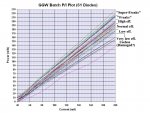Very good of you to offer the choices! The only problem, is that you end up with some diodes that you won't sell. Which is not too good for you my friend... (your wallet)
Yes, diodes under "Normal" are the ones i get stuck with.. I calculated this to be 16.4% of the above plotted batch..
And it did hurt my wallet, because i didn't plan for it from the start. If i don't separate diode efficiencies by price, naturally everyone will go for the good ones by default!
10 "useless" GGWs make for $550 USD! However that was a part of the cost of getting to the 51 good or better ones! Unfortunatelly there is no way around it.
But now i explain this to my buyers as well, and that since those diodes would have died much faster, i have to weed them out, take their cost and spread it out over the rest of the diodes - the ones that are good or better are worth that much more...
That's what
the GGW laser base price is all about - it
guarantees everyone gets at least a good Normal GGW diode in their laser...
Again it can be set to "any" power desired, even above 200mW if pushed, but the current WILL affect it's life.
If the current requested is not too high, every "Normal" or better GGW diode is also covered by a "Birth Defect Warranty" (just in case something were to slip through my Pre-Testing)...
If someone wants more power than that, there are
the High efficiency diodes, Freaks and so on - but those
have to cost a little more, for the simple reason that they are worth more, not just because they are better, but also because there is less of them in a batch.
And i have to buy a batch with all types to get to the good ones.....
Same goes for high wavelengths - they cost a little extra on top of the base price...
Since there are no random diodes with me, the buyer gets to chose exactly what they want.
They pay a little more, but they know 100% for sure, they won't get a weak diode that peaked at ~175mW (or less) during pre-testing, pushed to 230-240mA, when they ask for a >200mW laser..
That laser wouldn't last very long - even at only 200mA those diodes often die in hours!
But that is exactly what would happen if i was using "random" diodes (next one from a bag), and setting them to whatever current required to reach the desired power - every now and then i'd have to push a diode to bizzare currents to get it to the power i am asked!
Because of this i had to change my diode pricing system. The whole point behind it is, that when i'm out of all diodes and only left with the weak ones, that i still got the money for the entire diode batch back - including the ones that were weak and useless (so i can buy another batch of diodes, where there will again be weak and useless ones)....
The buyer benefits from all this testing and selection, and it takes me a lot of time, so it only makes sense that it costs something...
If someone on the other hand doesn't believe it's worth it, they are free to try a lower efficiency diode at a discount - in the end it'll cost them more than going with a good one from the start, since there is a good chance they'll have to replace it soon (and when they do, they'll probably be asking for a good one).
However, so far when i explained the situation, everyone understood it rather well.
Now that i have a visual representation of this, explaining it will be even easier..
In the end i still get something out of those weaker diodes - data, if nothing else.. The various experiments provide a lot of it.
If i kill a bunch of weak diodes i don't have to feel bad, but i do establish some absolute minimums, when it comes to lifetime, and i know that the better diodes will live longer from experience.. Not to mention that the weak diodes make for good heatsink-testers.... :evil:
It hurts much more, when i have to kill a good diode, but i had two where the windows dislodged during cleaning - they became useless for builds and "volunteered" for the Torture Chamber. :angel:
I'll add the Cycler (life-time) data to the Batch Testing thread as well.
Another thing is.. Except for the "Very low" efficiency diodes, which clearly seem to indicate there is something wrong with them, i think the "Low" ones - those that peaked between 170-180mW @ 200mA and still cling to the main group in the graphs - could still be used as reliable lower power lasers at reduced currents...
They might be able to fill the gap between PHRs and GGWs - set to 140-160mW (depending on their starting efficiency) they should be reliable, and at the same time a lot better than 4x's!
So i'm hoping i'll still be able to use some of them in the end, for medium power / lower cost lasers....
 , I'll try to add some more pictures....
, I'll try to add some more pictures....



